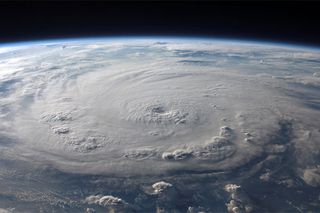Will Hurricanes Ever Reach Category 6?

As it moved toward to coast of Louisiana today, Hurricane Isaac was upgraded to a Category 1 on a scale that tops out at 5.
With wind speeds of about 75 miles per hour, Hurricane Isaac just barely earned the designation. Only at minimum speeds of 74 mph do winds become strong enough to cause significant damage, according to the National Hurricane Center.
Even though Category 5 storms, which sustain catastrophic gusts that blow at 157 mph or higher, are extremely rare, scientists predict an increase in strong hurricanes with global warming. That raises the question: Will we ever need to push the hurricane scale up to a 6?
STORM TRACKER: Hurricane Isaac Slams Louisiana Coast
Probably not, experts say. Even as warmer ocean temperatures provide more fuel for hurricanes, there are several factors that limit how powerful the storms can become.
For now, about 200 mph is the highest that hurricane winds can theoretically get -- and only three land-falling storms have come close in the past century, said Mark DeMaria, a research meteorologist with the National Oceanic and Atmospheric Administration in Ft. Collins, Colo. With warming, according to some models, the upper boundry could reach 220 mph.
Even then, recommended actions wouldn't change because devastation is already extreme at the limits we face now, DeMaria said. What probably matters more for people who live in hurricane zones is how many storms of Category 3 or higher end up hitting land.
Sign up for the Live Science daily newsletter now
Get the world’s most fascinating discoveries delivered straight to your inbox.
"Once you get to that point where your roof starts to come apart and the windows break, damage rises quickly," DeMaria said. "Once the walls are down and your house is flooded, going to a higher level doesn't change things much."
BLOG: The Fastest Winds in a Hurricane
"Category 5 storms are now extremely rare to start with," he added. "There would have to be a significant shift in climate to even consider doing anything besides what we are doing now. I think a shift that big is pretty unlikely."
For a hurricane to form, DeMaria said, there has to be a big enough difference in temperature between a cool atmosphere and a warm sea surface. In the Atlantic, conditions are favorable for hurricanes for about six months of the year, but strong storms only take shape when an atmospheric disturbance comes through.
If powerful wind currents blow east from Africa, for example, they can pull heat from the ocean into the atmosphere, while also triggering evaporation. As the air warms, pressure drops, which draws in more wind from the sides of the forming storm.
"That makes the wind speed higher, which taps more heat," DeMaria said. "It's a process that runs away with itself."
In the 1970s, the National Hurricane Center began using categories to describe how strong a hurricane's winds are and how much damage its gusts might be expected to cause.
Starting at 74 mph, Category 1 hurricanes can snap large branches off of trees, down power lines and damage the outsides of well-constructed homes. But hurricanes aren't considered "major" until they reach Category 3, with wind speeds between 111 mph and 129 mph. These gusts can cause devastating damage to homes and knock out power and water supplies for days.
Category 5 storms, whose winds blow at 157 mph or higher, destroy houses, rip down power poles and leave areas uninhabitable for weeks or even months.
Only three Category 5 storms have hit the United States since the beginning of the 20th century: a 1935 storm in the Florida Keys, Hurricane Camille in 1969, and Andrew in 1992.
With wind speeds measured at 190 mph, Camille holds the record for the strongest winds of any storm upon landfall in the U.S. Strong storms often weaken when they hit land because they lose their heat source and because friction slows winds down once they start hitting structures.
BLOG: Pets During Hurricanes: What To Do
But wind speeds don't tell the whole story, said John Abraham, a thermal scientist at the University of St. Thomas in St. Paul, Minn. The size of a storm, the amount of rain it dumps, and the size of the wave surges it produces also determine how damaging a hurricane will be, even though the category scale doesn't take those details into account.
All of those factors are likely to get worse with climate warming, Abraham said. As glaciers melt and oceans rise, for example, storm surges are likely to be higher. A warmer atmosphere can also hold more moisture, increasing the potential for heavier rains. And warmer sea surface temperatures increase the likelihood of storms whipping up fierce winds.
Still, a surge in Category 5 super-hurricanes is unlikely. One reason is that hurricanes pull cold water up to the surface from the depths as they churn through, and the cooling effect acts in a self-limiting way. And even though oceans are getting warmer, water temperatures would have to rise more and faster than expected to produce the strongest possible storms.
But storms of Category 3 and above are likely to become more common. In fact, scientists have already observed an uptick in intense hurricanes since 1970, according to an upcoming report from the Intergovernmental Panel on Climate Change, which Abraham has reviewed. And a rating of Category 3 is enough to destroy lives.
In addition to the severe droughts and floods that have struck around the country in the last year or two, Abraham said, powerful hurricanes are adding to the economic toll that weather is increasingly taking on our society.
"The hurricanes that really matter, that cause damage, are increasing," Abraham said. "What scientists have been saying would happen for decades is now happening. There's an economic cost to not doing anything about this problem."
This story was provided by Discovery News.
Most Popular

